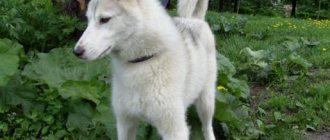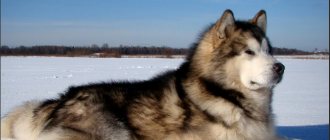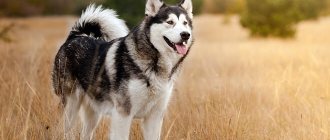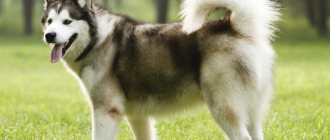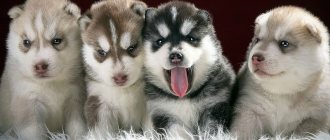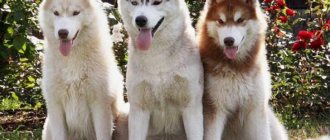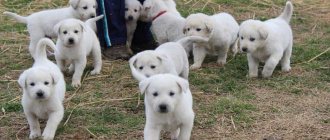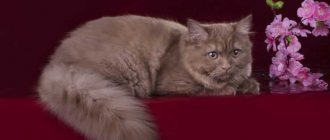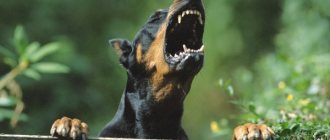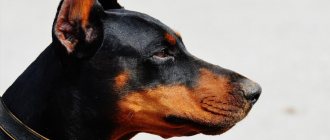Husky and Malamute mixes, despite the fact that they are not allowed for exhibitions and breeding, enjoy a certain popularity.
Moreover, among their fans there are many more professional breeders than just amateurs.
Why are such crossbreds so attractive for participants in sports competitions and for ordinary owners?
Like all other mestizos, these dogs take from both their parents not only their appearance, but also their character traits and working qualities, which makes such a pet unique and inimitable in its own way.
A cross between a husky and a malamute - a description of the breed and what it looks like in the photo
A cross between a Husky and a Malamute, called an Alaskan, looks like a cross between these two breeds . He is larger and fluffier than a husky, and his bones are more powerful and strong.
In such a cross, the head may also be more massive, and the ears are set quite widely apart. Eye color can be anything acceptable for each breed: brown or bluish.
Also among mestizos, heterochromia occurs, in which one eye is dark and the other is light blue.
Alaskans successfully combine the agility and agility of huskies with the power and strength characteristic of malamutes.
Such dogs are distinguished by their speed and agility, while they are very hardy and show excellent results in sledding sports.
Mixed Caucasian Shepherd and Husky or mixed Alabai and Husky. What's better?
Several years ago, on the basis of the working kennel of the GUIN Ministry of Justice of the Russian Federation (Tomsk region), they tried to obtain a stable hybrid of the Central Asian Shepherd Dog and a Husky (a cross between a Husky and an Alabai).
Mixed husky and alabai
Caucasian Shepherd Dogs were also included in the experimental group, as representatives of strong and quite vicious breeds that have long established themselves as excellent representatives in the ZKS (protective guard service).
What did the husky mixture take in?
From huskies, mestizos, along with a greater lightness of physique, also inherit such features as agility and excellent running qualities . Many crossbreeds inherit the Husky's blue eye color, narrower muzzle, pointed ears and coat type.
In their character traits and attitude towards people, they also take a lot from huskies. Such mestizos are active and playful, they adore their owners and are ready to follow them everywhere.
By inheritance from the husky, the Alaskan may inherit a stubborn disposition and willfulness, which, given the large size and physical strength of the dog, can cause difficulties in the process of raising it.
Husky mix
Hybrids of Malamutes and Laikas, bred to improve the running speed of dogs, are distinguished by lighter bones and a friendly, calm disposition. Interbreeding with huskies was also carried out so that the hybrids, distinguished by their robust build and endurance, could become reliable hunting assistants.
Outwardly, they look somewhat larger and more massive than huskies, in addition, their fur is usually medium in length. Their facial expression is not so phlegmatic and good-natured: the look of the Malamute-Laika mix expresses attentiveness and interest, while that of the Malamute is calm and at the same time friendly.
By nature, mixed breeds with huskies are usually quite friendly towards people, and they have a well- developed hunting instinct , thanks to which their dogs can also be used for hunting.
What traits did she take from the Malamute?
From the Malamute, the mestizos got large stature and a rather powerful physique . Strength, endurance and a more balanced temperament than that of the husky also came to them from the Malamutes.
In external features, the similarity of Alaskans with Malamutes can also be seen in a more massive skull and a relatively wide muzzle. Their ears are also set quite wide apart, almost like a Malamute.
Many Alaskans also inherit from them the expression of their eyes: unlike huskies, whose faces seem to have curiosity and playfulness imprinted on them, the look of most mestizos is calm and good-natured.
From the Malamute, the Alaskan can also inherit a dominant attitude towards other dogs, as well as intolerance towards small animals.
Differences in appearance between adult dogs
To understand how to distinguish a husky from a malamute, you need to know a number of features of each breed. Below are points by which these breeds can be compared.
Dimensions, weight and other distinctive features
Toy terrier and toy chihuahua: differences, who to choose
An adult Malamute can reach 40 kg or more (male) and 33 kg (female). Huskies are smaller - 28 kg (male) and 23 kg (female). The average height of a husky is 50-60 cm at the withers; the height of a malamute varies from 55 to 65 cm at the withers.
Who is bigger
From the previous paragraph it is clear that the malamute, unlike the husky, is larger in size. This is also visible externally; when visually comparing animals of these breeds, the difference is very noticeable.
Nose color
By standards, a snow nose is acceptable in both breeds. Red Malamutes should have a brown nose, while dogs of other colors should have a black nose.
Note! White huskies have a pink nose, red ones have a liver nose, and the rest have a black nose.
Ears
Malamutes have small ears compared to their heads, set quite wide apart and slightly tilted forward. Huskies have medium-sized ears, thick with a lot of fur, they are set high on the head, looking straight up.
Head and eyes
Malamutes have a larger head than a husky and a voluminous muzzle. The Husky has a medium sized conical head. The eyes of Malamutes are almond-shaped, not large, always dark in color, slanted, the corners of the eyes are slightly raised. The second breed has medium-sized eyes, the corners are also slightly raised.
Important! The color can be either brown or blue, heterochromia is allowed, that is, different eye colors. It even happens that one eye is half brown and half blue.
Tail
Malamutes have a fluffy, long tail, may not be completely curled into a ring, located no lower than the level of the back, thrown behind the back, but not pressed. This breed's tail may be pulled back when moving. The husky's tail is also fluffy and long, but it is not bent into a ring, but straight. When moving, it is directed upward, in a calm position it hangs below the level of the back; these dogs have a so-called “fox tail”.
Coat and color
The differences in coat color are minor. Malamutes can be gray, black, sable, red, brown and white, and also white. Husky fur can be of almost any color: from black and brown to snow-white. Basically, dogs of both breeds are not monochromatic. The most common dogs are those with a white chest and belly and a dark back. The coat of Malamutes is much thicker and coarser than that of the Husky breed. They have a dense undercoat, similar to felt, and a coarse awn, that is, the top layer of wool. Huskies have a soft but dense undercoat, and the hair is straight and smooth, which is why Malamutes have longer coats and are fluffier and more voluminous.
Paws
Malamutes have wide paws, snowshoes with thick pads and fur between the toes. In Huskies, they are oval-shaped and medium in size. They, just like representatives of other breeds, have large pads and hair between their toes. In Malamutes, the knees have medium angles, slightly bent; in Huskies they are sharply angled and located close to the ground.
Pet Personality
As is the case with other mixed breeds, it is difficult to say which of its parents such a puppy will grow up to resemble. Considering that huskies and malamutes have opposite character traits, we can say that it all depends on how the genes line up.
If the puppy is more like a malamute, he will have a calm and good-natured disposition, but if he is a husky, he will grow up to be very active and playful.
One thing is certain: that his character will contain traits of both breeds. Metis will be very smart and quick-witted, although perhaps also cunning.
They will almost certainly inherit from both their parents the desire to dig up the ground and the ability to make tunnels, therefore, if the owner does not want his pet to wander on its own, he will have to take care of a reliable fence or enclosure from which the Alaskan cannot get out.
Many owners of such dogs note that Alaskans tend to have a dominant attitude towards other dogs . But they treat children very well: such pets make wonderful playmates for children.
NOTE!
Such dogs may be too friendly and trusting of strangers, which makes their use as guards inappropriate.
Mestizos are especially loyal to their owners and are people-oriented, which significantly facilitates the process of training them..
Many people who decide to buy such a dog think that the character of their pet will be average between the temperament of a husky and the phlegmatic nature of a malamute, but there is rarely a “golden mean” in the character of Alaskans.
Much more often, a puppy inherits most of its traits from one breed or another.
German Shepherd mix
A cross between a Malamute and a German Shepherd received a beautiful and unusual name - utonagan , which translated from one of the Indian dialects means “spirit of the wolf”.
And, indeed, outwardly, Utonagans are very similar to wild gray predators, although they are somewhat smaller and longer-haired. The size of the utonagan can range from 55 to 65 cm, which is quite commensurate with the growth of both malamutes and shepherd dogs. The physique of these dogs is strong, but without signs of excessive massiveness or stockiness.
Having inherited a benevolent disposition from the Malamute, and impeccable obedience, distrust of strangers and innate hunting instincts from the Shepherd, this mixed breed is a universal breed, ideal for the role of a companion. He has a beautiful and extraordinary appearance, is strong, resilient and friendly towards his owners.
The service qualities and obedience inherited from the shepherd significantly facilitate the process of training a Utonagan and make it possible to use these dogs to guard a house or apartment.
Utonagan is ideal for the role of a family dog - he is good-natured, calm and very good with children.
Dimensions, weight and other distinctive features
The height of an Alaskan dog is usually greater than that of a husky, but less than that of a malamute: on average, it is 56-58 cm at the withers, but can be from 52 to 65 cm.
The average weight of such dogs is 30-34 kg.
But, depending on the characteristics of the physique and the massiveness of the skeleton, their weight can range from 20 to 43 kg:
- The body of the mestizos is almost square in format: its length exceeds the height at the withers by no more than 1-2 cm.
- The bones are strong, but the dog does not look too massive. The Alaskan has a moderately wide head and a not too long muzzle, similar to that of a wolf.
- The ears are pointed, triangular in shape, set relatively close.
- The eyes are almond-shaped, medium in size, blue or brown. Heterochromia is also allowed.
- Alaskans have a friendly, but at the same time slightly wary look.
- The neck is strong, the withers are well developed, the back is straight and strong, the croup is slightly sloping.
- The tail is well feathered and may be carried over the back or drooped.
- The limbs are strong, muscular and robust. At the same time, Alaskans are characterized by some high-leggedness.
- The fur is thick and dense, often forming a kind of small fringe around the neck and on the tail.
The color can be any color acceptable for each breed, including pure white.
Outwardly, Alaskans resemble a wolf more than representatives of each of the two original breeds, which is why they are often mistaken for wild animals.
Expert opinion
Kozhevin Semyon Kirillovich
Expert dog handler.
“Alaskans usually inherit the best qualities from Huskies and Malamutes. From the first breed they take speed, agility and a playful disposition, from the second - prudence, a more balanced temperament, strength and power. Outwardly, such mestizos look like a cross between malamutes and huskies and are often more similar to wolves than both of them. These dogs are distinguished by great endurance and unpretentiousness in keeping and feeding. As for their health, Alaskans live long enough and rarely get sick.”
Hybridization results
“What happens if you cross a Husky and a German Shepherd?” - thought the newly minted US breeders and mixed the two breeds into a single hybrid.
The resulting mestizo pleased with his appearance, beauty and stature, lively mind and ability to sleep for a short time in the snow in a blizzard.
It turned out that in an attempt to improve, many of the working qualities of two separately superior breeds were lost - the German Shepherd and the Siberian Husky.
The resulting mixed “breed” did not acquire the endurance over long runs typical of sled dogs – once again.
The unconditional obedience and desire to please the owner, developed in the German Shepherd through long decades of selective selection, was lost - two.
The cute bastard (two+ blood - “double blood” in English) disappointed the creators with instability of behavior and inability to pass on the best external and working qualities to his descendants - three.
A cross between a German Shepherd and a Husky, it turned out to be good only as a large decorative dog, which became popular in Canada and the States.
Smart, agile, affectionate, mischievous and devoid of any manifestations of aggression (maximum - hoarse, angry barking with an imitation of an attack), the Gerberian Shepski was recommended as a “therapeutic” dog in canistherapy and for keeping a pet at home.
Advantages and disadvantages
Pros:
- Beautiful.
- Strong and resilient.
- Show first-class results in sledding.
- Friendly to people.
- They make good companions for children.
- Inexpensive price.
- Unpretentious in feeding and maintenance.
- Good health.
Minuses:
- They may seem dangerous to strangers due to their external resemblance to a wolf.
- Not suitable for protection: too friendly towards all people.
- Not allowed for exhibitions and breeding.
- It is difficult to predict how such a puppy will grow up.
- Usually, they try to dominate other dogs, which makes it difficult to work in a harness.
The hunting instinct inherited from the Husky and the Malamute can make the Alaskan intolerant of cats and other smaller animals.
How to care
A very demanding dog to care for and maintain. She has long and thick hair, and on hot days the Malamute needs water treatments. They at least somehow help her freshen up. The breed does not tolerate high temperatures above zero.
You need to bathe your Malamute with a special product and rinse the fur thoroughly. Afterwards it needs to be dried well and combed. Hairballs can lead to the development of diseases.
The Malamute sheds twice a year: in spring and autumn. During shedding, the dog will have to be brushed every day. If this is not done, mats will form that will fly around the house or yard in huge clumps.
Malamutes need to rub their eyes with clean water once a week. Clean your ears once a month. Cut your nails once every month and a half.
Life expectancy and health
On average, Alaskans can live 12-15 years . At the same time, most of these mestizos are in good health.
But, given that husky and malamute are related breeds, a puppy from such parents may be predisposed to eye diseases, as well as diseases of the musculoskeletal system.
The gluttony inherited from the two original breeds makes such a dog prone to obesity . In addition, Alaskans can be susceptible to diabetes.
Features of maintenance and care
Husky and Malamute mixes can live both in a private house and in an apartment . But you need to take into account that if a puppy inherits the character of a husky, he may have a tendency to damage furniture and other things, and he may also howl from boredom when left at home alone.
Therefore, it is best to immediately wean him from this habit, and if the dog spoils things, it makes sense to think about purchasing a special cage or indoor enclosure for it.
In a private home, you need to keep an Alaskan either in a spacious enclosure or free-range in the yard, but not on a chain . In this case, it is necessary to take care of a reliable fence so that the dog cannot dig under it or get over it.
You will also have to ensure that the mestizo does not have access to poultry and small animals such as cats or rabbits. After all, the Alaskan may decide that they are his legitimate prey and start hunting them.
Caring for this dog is not difficult: the coat needs to be combed 1-2 times a week; during shedding, this procedure will have to be done daily..
Ears, eyes and teeth should be examined every morning and cleaned if dirty. If the Alaskan's claws do not grind down on their own, they should be shortened as necessary.
Mixed breeds do not need frequent bathing: it is enough to wash them 2-3 times a year or if the pet is very dirty.
How to identify a purebred husky from a crossbreed
Since there are a huge number of husky mixes, and some puppies look very similar to purebred representatives of the breed, before buying you need to know what to look for so as not to make a mistake. After all, most mestizos are much cheaper.
Important! Mixed breeds can be either in one generation or transmitted from one generation to another.
First of all, you should pay attention to the cost of the puppy. Purebred huskies will cost much more. Some breeders may offer to pick up mixed breeds for free.
It is important to know what breed the cross was made with. This will help you understand how difficult raising a dog will be, as well as find out the characteristics of the pet’s character and health. However, unscrupulous breeders may try to pass off a fake as a purebred animal.
Only a genetic test will give you 100% confidence that the puppy you are buying is a husky. If it is not possible to conduct it, you should rely on the documentation provided by the kennel and the dog’s pedigree.
The baby's appearance is unlikely to help, since appearance is formed only in adolescence, not earlier than 12 months.
Signs by which you can determine whether a husky is purebred:
- these dogs do not bark, but howl, regardless of the emotions expressed (barking is generally unusual for them);
- Huskies are excellent nannies, not all mixed breeds retain this trait;
- Huskies will not make guards, while in mixed breeds with some large breeds this instinct is very well developed;
- these dogs do not have a specific odor, since their coat is capable of self-cleaning;
- strong limbs are a prerequisite for purebred dogs, since they are sled dogs;
- Eye color is only blue - there can be no exceptions.
If you want to buy a purebred dog, you need to choose only a proven kennel that has a good reputation. You should definitely ask questions to the breeder. If he cannot answer them or is in doubt, it is better to go elsewhere for the puppy.
How and what to feed correctly
Alaskans, like representatives of the original breeds, do not suffer from lack of appetite . Rather, on the contrary: these dogs can eat almost anything and, at any opportunity, will not miss the chance to have something to eat.
Therefore, it is necessary to carefully monitor your pet’s diet: under no circumstances overfeed him and, of course, do not give him food from your table, no matter how pitifully he begs for it.
You can feed your Alaskan either natural food prepared at home or branded dry food . At the same time, the food must be fresh and of high quality.
With natural feeding, approximately 30% of the mixed breed's diet should be muscle meat or offal. But you need to take into account that you can give your pet liver only in a scalded form, and it is better not to treat your dog with lungs, udders and kidneys at all.
For meat, Alaskans should receive oatmeal, rice or buckwheat porridge, as well as raw or boiled vegetables and fresh, finely chopped herbs, with the exception of sorrel.
IMPORTANT!
It is also useful to give your pet fermented milk products, such as cottage cheese, kefir, natural yogurt, and from time to time you can pamper him with a piece of hard cheese.
If an Alaskan eats ready-made food, it must be at least premium and meet the age, size, physical activity and health status of the dog..
